The Changing Mindset of a Billion Minds
Introduction
Is there a mindset of the nation? Does this mindset change or evolve with time? How do we understand the cultural mindset of the people of a nation? What implications does it have for brands and businesses?
The economic liberalization of India, which was done in early nineties, has been epochal in its impact on how India lives and thinks. The opening up of the economy has opened up the minds of the people. While the economic story of emerging India is being told in terms of its successes in the services sector, and the continued policy of privatisation and deregulation. The country is witnessing a cultural re-ordering of its value system.
This has implications not only on people’s consumption behaviour but also the meaning system that brands and businesses need to carry so that they connect with the motivations of the time. The understanding is of importance for multinational businesses and as much if not more, for the homegrown businesses. Reason being that most home-grown Indian businesses have been built during the post independence era basis the traditional Indian value system. And as they shift gears to enter a new phase of growth, they need to imbibe and reflect the emerging values of the new times. As for multinationals, it’s important for them to understand in what ways the world of the Indian is changing and in what ways its not. An astute understanding of the degree and nature of change is critical for brands and businesses if we want a direct connect with the lives of the people.
This paper maps the emerging mindset of India and how its cultural codes are changing in the context of the economic resurgence of the country. In doing so, it demonstrates through application, the need to understand people and their motivations at a collective level so that brands and businesses can be a part of the larger cultural discourse of the country.
The Analytical Approach
Mapping the changing cultural mindset of a nation however, means understanding people and how they live versus understanding consumers and how they consume. This sets up the need to understand the changing ‘culture’ of the new India read as, “a set of control mechanisms – plans, recipes, rules, instructions (what computer engineers call a program), for the governing of behaviour” (Geertz, 1973).
The study followed an analytical approach, which meant looking at everyday, unconscious behaviour and inferring the underlying pattern behind these ‘behaviour scraps’. Interpreting popular culture such as blockbuster cinema, street fashion and music, newspaper headlines, youth role models, popular television programs also provided useful insights. The analysis comprised observations, secondary research and was backed up by Bates Change Point Panels, our expert panels drawn from distinct fields of the society including business journalism, sociology, marketing, popular culture etc. The ‘Change Diary’ that captures observations on change is an ongoing effort that opened new areas of inquiry.
The conceptual framework used is a modified version of the model developed by Geert Hofstede (Hofstede, 1991) to map cultures (see Figure 1).
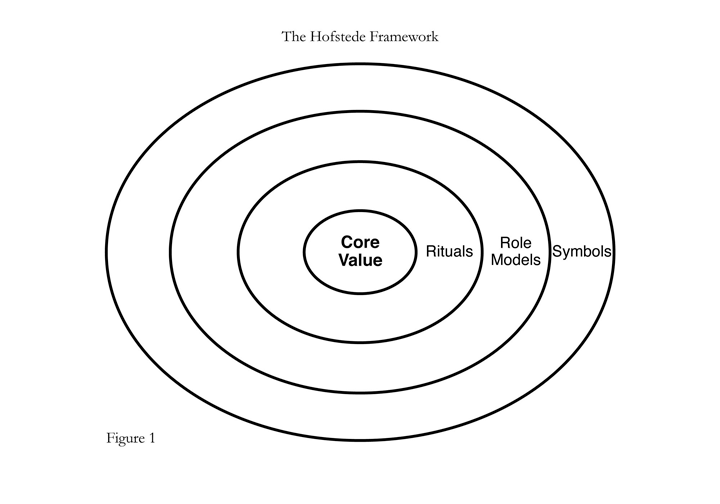
Hofstede propounds that at the heart of every culture lies the Core Value, which is the culture’s driving idea, the grand unifying impulse. This is expressed further through a set of Rituals interpreted in this case to mean Cultural Codes, which act as a set of implicit rules that the culture follows. The core value gets reflected in Role Models, who represent best what the culture holds dear. And finally, the culture’s driving impulse finds expression in everyday behaviour or Symbols that carry within albeit unconsciously, the culture’s intent.
The Emerging Mindset
The emerging Indian mindset is finding its roots in the Kshatriya values of the traditional warrior class as against the Brahminical values of the priestly knowledge class that has been the biggest influencer of the Indian mindset so far.
The new India has found a leaf within its cultural roots in the Kshatriya way of life which is putting an accent on extrinsic values of action, success, winning, glory and heroism as against the Brahminical values of knowledge, adjustment, simplicity and restraint which has always dominated the Indian way of life. Evidently so, the newer mindset is rooted more in ‘action’ than the ‘knowledge’ orientation of the traditional Indian mindset.
This change in the mindset of the new India is becoming the cultural engine of the Indian economic charge. Individual entropies of the young people are adding up to provide a larger momentum to the country on the whole. Considering that more than 500 million Indians are below the age of 21 yrs and its median age of 25 is even lower than that of China (33) that should make for quite a force.
Changing the Cultural Codes
The changing mindset in its wake is redefining what’s culturally desirable. The new behaviour codes are in principle different from the codes that have traditionally governed the Indian mindset. The change is visible in everyday behaviour of people, their dreams and aspirations, their career choices and the overall approach to life. This change appears to be driven by a core value that pretty much defines the way the new India is thinking.
Seeking A ‘Karmic Transformation’ – The Core Value of the New Indian Culture
Karma in Hinduism is your fate. One’s individual Karma is a result of one’s actions. Thus according to Hinduism, our life is a function of our fate, shaped by our actions. While traditionally, Indians have taken refuge in the idea of Karma and its interpretation that our life is governed by our fate hence not much can be done to change what’s writ. The new India is seeking to transform its Karma. The emerging belief is that Karma is shaped by your actions and its possible therefore to transform your being; to achieve a life that you desire than live the one that’s destined.
The India of today is seeking a ‘Karmic Transformation’. Nothing is writ for today’s India. A refusal to accept their current state of being and a burning desire to transform their lives marks the spirit of this new generation. This desire and belief of being able to change ones’ destiny is the driving idea (core value) of the changing Indian mindset (see Figure 2).
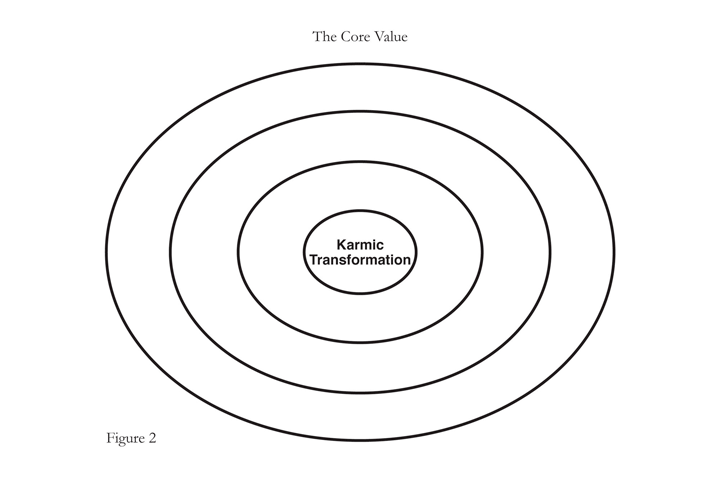
The core value of ‘Karmic Transformation’ manifests itself in five key cultural codes.
1. Activating Your Destiny
One of the biggest changes in today’s India and especially the younger Indians is the belief in being able to break the birth barriers. The India of today does not recognize any limitations of class, country, gender or economics in its pursuit to realize its true self-potential. This is a marked departure from how Indians have always lived, with an unquestioned belief in the idea of destiny.
The omnipotence of destiny tied an Indian to his birth variables forever. His profession, marriage, social circle were all determined by where and to whom he was born. The variables of birth continued to wield their power on an Indian’s life through the modern India as a severe lack of resources ensured that an average middle class could almost never escape his socio-economic bracket. Not any more so. Indians today believe that they can activate their destiny by sheer dint of their efforts and ability (see Figure 3).
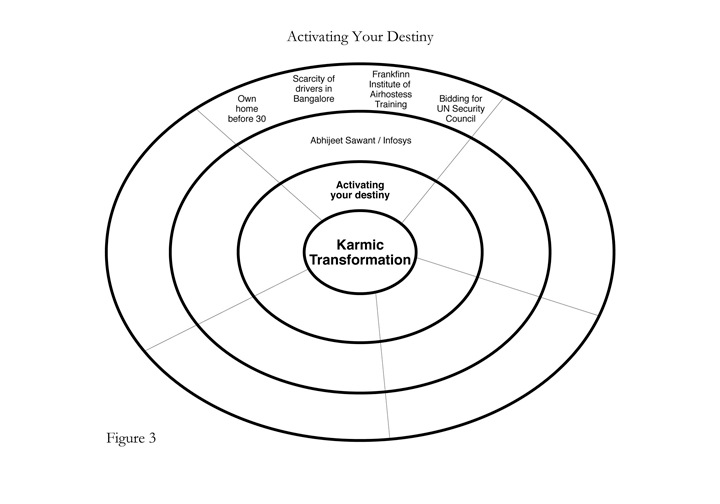
This cultural code is making itself visible in many ways. For instance, the average age of new homebuyers in India is early 30s and is declining every year. The India of yesteryears could almost be divided into two halves on the basis of people who owned their own abode and those who dreamt of doing so most of their active years. And if they were lucky they could accumulate just about enough money by the time of retirement to own a modest house. Owning your own house at the age of 30 is thus one of the biggest hurdles that a young Indian today crosses in being the master of his own destiny.
The impact of change is not confined to the upper strata of the society. A city like Bangalore is facing a genuine scarcity of chauffeurs. In general, the Southern states in India are more conversant with English as a language than say the Northern states. As such, most of the people who worked as chauffeurs in a city like Bangalore, had some fluency in English as a language. And the boom in the services sector has meant that anyone who could speak some bit of English and is open to working hard and get trained is a sought after one by the BPO industry. Many chauffeurs in Bangalore have joined the BPO industry at salaries four to five times higher than what they probably earned driving someone else’s car.
The change is visible also in the sheer number of young women joining the workforce and building careers that till now they could only dream of. One of the most potent symbols of this change is the ‘Frankfinn Institute of Airhostess Training’, which has over 60 centres, dotting several small towns on the map of India. The institute as the name suggests is making it possible for young girls from all over India to take a shot at a career of glamour and independence. Culturally speaking, the Frankfinn Institute is symbolic of the flight that young Indians today are taking to a life of their dreams and desire, irrespective of their gender, class and place of birth.
The buoyancy and aggression however, is not limited to everyday people. The fervour and confidence with which the Indian government has mounted its bid for a seat at the UN Security Council is no less a symbol of the new found confidence of the nation and its people. The desire at all levels in today’s India is to go out and make things happen and not sit content with what’s happening on its own. The feeling on the streets is that of genuine optimism, a feeling that its India’s times for a metamorphosis into a world butterfly.
Indian Idol (the Indian version of the American Idol) finished its second successful session recently. In India, Indian Idol has been more than just a TV programme; it has been a social phenomenon. It has given a window of fame, glory and success to those who have the talent but no resources. The first Indian Idol, Abhijeet Sawant comes from a lower middle class locality in Mumbai and was born to a clerk in the Mumbai municipal corporation. Abhijeet Sawant today is the role model of every Indian who believes that one day he will be able to find his calling by sheer dint of talent. Visible successes of people like Narayanmurthy who have built a world class IT organization like Infosys with zero start-up capital but immense ability and confidence is making people believe that they can do it too. Ability and intellect in today’s India are seen as the weapons to achieve a life of your dreams. Abhijeet Sawant and Infosys are in many ways the role models who typify the cultural code of ‘Activating Your Destiny’.
2. Currency to Extrinsic Values
The traditional way of living through the ‘Brahminical’ values meant upholding the principles of simplicity, giving precedence to means over ends and choosing correctness over opportunity. ‘Simple living, high thinking’ and ‘mind over matter’ have been the tenets of the traditional Indian way of life.
For the first time however about a year back, 60 million households (those with Cable & Satellite connection) in India collectively got exposed to a term called ‘X Factor’. ‘X Factor’ or more specifically the lack of it, was what the judges of the TV reality show Indian Idol, used to decimate the chances of many talented singers, some with over 12 years of training in classical music. For the first time the Indian middleclass realized the importance of looking good, dancing well and being stage friendly. They realized that 12 years of training in classical singing may not be enough to win a talent competition, but being able to perform like a rock-star might be. For a Brahminical India, which valued talent over flair, substance over style and academics over personality, realizing the importance of the so called ‘X Factor’ marks a never before shift in the mindset. The concept of X Factor in many ways defines the code of ‘currency to extrinsic values’ that the new India is learning faster than they probably thought they could (see Figure 4).
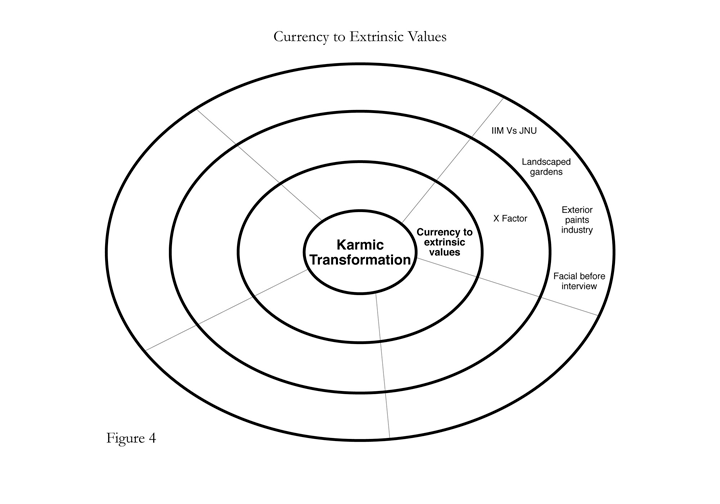
The changing value system makes itself evident in the ranking of educational institutes for instant. JNU (Jawaharlal Nehru University) has traditionally been the revered seat of academics in India. The university offers Post Graduate programs in social sciences and specializes in social studies. JNU has been the beacon of academic pursuit and has provided the talent pool for the most elite Indian Civil Services. The crown of the most prestigious institute in India however, has quietly slipped away from JNU to the IIM (Indian Institute Of Management). Not surprisingly so because, IIM is the institute that made Indian middleclass believe that they too can have access to a per annum salary of US$200,000 and a job that sits out of New York or Singapore if they could crack its rather difficult entrance examination.
Education has gone practical in India. People have realized the value of enrolling into a three-year diploma course in IT from a private education player like NIIT (the largest private player in computer education in India) over pursuing an undergraduate course in Economics or Biochemistry. It’s the salary value of the course that is determining the importance of an institute not the depth of education. This when being a Ph. D. or an M.A. (Master of Arts) was a matter of such pride in India that it went prominently on the nameplate that was hung outside people’s houses.
Traditional Indian mindset attached little value to things ornamental. A train journey through the countryside will get you to see huge houses built on large plots of land neither plastered nor painted. It was important to own a large house, it was never so important to make it look good. Contrast that with the fact that the biggest hooks that real estate advertising today is using are about landscaped gardens, Italian marble on the floors and use of weatherproof emulsion on the exteriors. The boom in the exterior paints industry in India is certainly symbolic of a shift in mindset, from an absolute accent on intrinsic values to recognizing the merit of values that are extrinsic in nature.
The changes in the meaning of beauty and its role in everyday life is another such example. In one of the consumer interactions, young men confessed to going through elaborate facial and beauty treatments before an important interview. Not only did they believe that looking good was important for them to feel confident within, but some of them strongly believed that if they looked good, the prospective employers would feel they would be good at work as well.
The India of today is putting a never before focus on extrinsic values. For today’s generation ends are as important if not more than means. Talent is not much of an asset if it doesn’t have the money value. It’s important for this generation to celebrate success and achievement. The Kshatriya (warrior class) values of winning, success, glory and heroism are gradually pushing out the Brahminical (priestly class) values of mind over matter, means over ends and correctness over play.
3. Criticality of the Last Lap
It has been a common refrain in India for many years that the Indian cricket team lacks the killer instinct. We have always produced excellent batsmen but go-getter fast bowling had always eluded India. Fielding in a cricket match has been something that the Indian team always looked at as a low-end blue-collar job. Best of the Indian batsmen would retire hurt when it came to fielding to avoid wasting their energy on something silly as that.
A lot of this has changed for the current Indian team. The Indian team today is chasing big targets and winning matches that are tight to the last ball. They are going after the difficult catches and stopping the seemingly insignificant but not so insignificant ones and twos. Those who are familiar with the current team would know that there is a Kaif in the Indian team today whose biggest contribution is tight fielding and coverage in the slips. There is a new sensibility emerging, which is recognizing the criticality of the last lap. The change in the team outlook is a reflection of a larger outlook transformation that India is going through. We are realizing as a community, the value of staying on till the end and finishing things (see Figure 5).
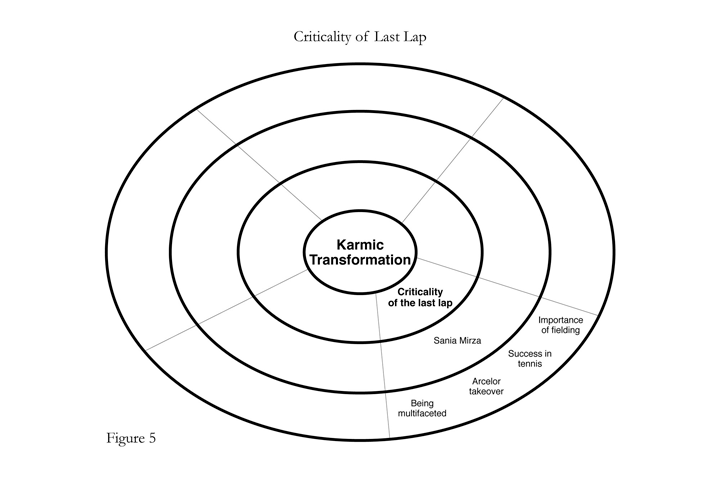
The result is that while India has always done well in things cerebral such as chess championships and mathematics Olympiads; we are now beginning to get medals in intense sports like tennis and athletics. The role models of this new Indian sensibility are people like Sania Mirza (40th in WTA rankings April 2006) and Rajyavardhan Rathore (Olympic silver in double trap shooting at Athens) who have got India accolades in sports that we almost feared competing in.
In the year that went by, the entire world witnessed the dramatic takeover of the French steel company Arcelor by Mittal Steel, a company owned by an Indian though not operating out of India. The sheer perseverance with which Lakshmi Niwas Mittal approached the deal, making offers, aggressive counter offers, parlaying with the involved governments and stakeholders was a spectacle in the art of ‘last mile closure’.
The attitude of pushing to the limits and not letting go is visible in the way the current generation lives its life. Multitasking and being multifaceted is a common nature with them. Catch hold of any young kid in India today and her daily routine will baffle you with the sheer number of activities she is able to pack in one single day, activities ranging from a dance class to mathematics lessons. Going out and doing your thing is becoming the philosophy of the new India. Indians today are playing to win; unlike the traditional Nehruvian philosophy of participation is more important than winning. This code though most evident in fields such as sports is becoming the dominant way in which life is being approached.
4. Finding Extraordinariness
Hindi films are a good barometer of the Indian culture and its mood. Rang De Basanti has been a blockbuster film of the year 2006 in India. The film deals with issues of inaction and apathy on the part of Indian youth. While the film is painted in the hues of patriotism and nationalism, the real appeal of the film lies in the characterization of its protagonists. Time has been spent in establishing the protagonists of the film who are a bunch of four friends on a college campus without a purposeful existence. Till one of them who had joined the Indian Air Force crashed in a MIG fighter aircraft much maligned for their failing machinery and government inaction to replace them. The loss of someone so close led to a good-for-nothing gang of college friends turning social activists and finally embracing martyrdom. The film has been a blockbuster success, and while its only good that it has not provoked young Indians to go up in arms against the system, what it has certainly managed to do is to plant a desire in an average young Indian to seek ‘extraordinariness’ in his/her own right (see Figure 6).
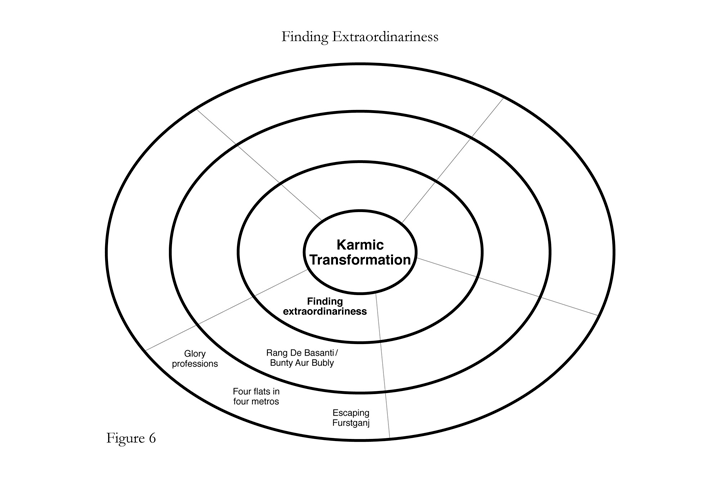
Bunty Aur Bubly another movie that has been a blockbuster success across India has at the heart of its story, the desire of a young boy and a young girl from the small town India to escape Fursatganj a symbolic small thinking town and make it big in the city of big dreams – Mumbai. The most defining moment of the movie is when the film’s protagonist refuses to go for a government clerk job interview, which his father has set up through reference. His refrain to his father is that the job that you have set up for me has neither recognition, nor fun nor fame – the three critical parameters that the Indian youth uses to evaluate anything including a career. As the film sequence goes on to highlight, a set of values exactly opposite to the values of hard work, respect and honesty that his father lived by, spending more than two decades in the government job of a ticket collector for the Indian Railways.
The biggest fear in today’s Indian youth is being ordinary. Their desire is to be extraordinary in everything they do. Their dreams are non-linear and are being supported in kind by high starting salaries, easy availability of finance and an ever-expanding choice in consumption. In a recent consumer interaction, a middle class youth prominently announced that his dream was to own four apartments in all the four major metropolitan cities in India. On being quizzed further, as to how exactly he planned to achieve it, there weren’t any clear plans, but his confidence and optimism remained unfazed. The path to the dream may not be charted exactly, but the end point of being extraordinary is extremely clear to today’s India.
The desire to be untypical is visible in the changing profile of most preferred careers as well. Media, airlines, modelling and sports as career options hitherto a choice of a brave few are finding popular acceptance. Increasing number of professionals with fairly well charted career paths are opting out of everyday 9 to 5 jobs to chase their own dreams of entrepreneurship, fame and glory. The safe playing Indians who made efforts to blend in and be part of the social whole are today universally seeking opportunities that will make them stand out; bring them extraordinariness!
5. Making Use of Tradition
While so much is changing in India, some things are not. Contrary to the fear of Westernisation, the younger generation has not thrown away its traditions. They are in fact making use of tradition to their advantage. For instance there is almost a trend in India now a days to make your name numerology friendly. Fairly well educated and modern Indians would suddenly add an additional alphabet to their long-standing name so that the sum total of their name alphabets falls in line with the astrological recommendations (see Figure 7).
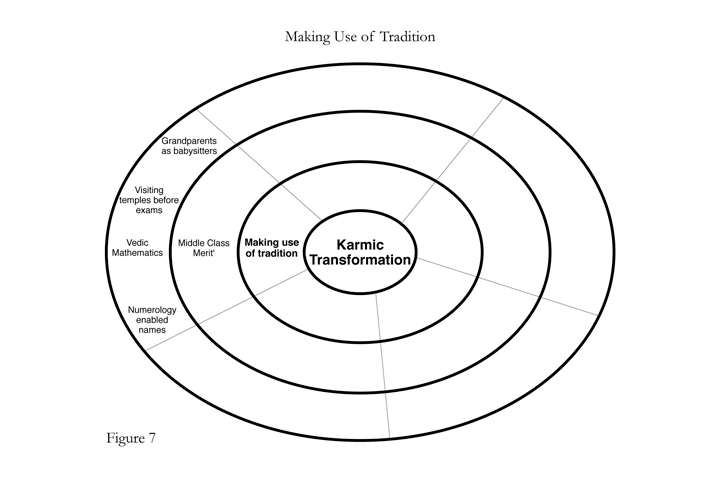
Another interesting example of using tradition to advantage is the resurgence of Vedic Mathematics. CAT (Common Admission Test) is the GMAT equivalent for entry into the Indian Institute Of Management. Unlike GMAT however, CAT has an exceptionally high difficulty level in quantitative ability. Vedic Mathematics has come to the rescue of Indian students with its shortcut methods to solve complex mathematical problems. The methodology is now being formally taught in many training institutes, which help students prepare for these entrance tests.
In their march to success and glory, young Indians are taking whatever help they can garner. And even god and religion are contributing their bit. So if its examination times, its not surprising to see the queues outside the famous temples get a bit longer. Newspapers frequently carry stories of highly successful film stars, politicians and other dignitaries from public life visiting famous shrines just before an important even in life or immediately after some success to get the blessings of the almighty. India is probably unique in how the role of divine intervention fits seamlessly with the desire to change one’s destiny as a continuous whole.
Tradition has also come to the rescue of working couples wanting to start a family. The joint family system ensures that the grandparents bring up the children with all the right values while the young parents are busy burning the midnight oil at office. The joint family itself however has evolved to give much more freedom to its members. It’s not uncommon to see younger people create their own microcosm in a room within the joint family. The personal rooms within the family nowadays are well stocked with a refrigerator, television and in some cases a handy supply of alcohol. The joint family, where it continues to exist, has grown up to give the current generation an access to the best of both the worlds. Freedom to live their own life, the way they want to with the backing of a support system. The individual in India has found a place within the social, another example of using tradition to your advantage.
An integral part of the Indian tradition that is being carried forward is the quintessential ‘middle class merit’. Rahul Dravid – the captain of the Indian cricket team, is a role model of a conscientious, regimen driven success of the Indian middle class merit. His media profile is made up of stories about how his parents put a big accent on getting the studies right and how he never missed school and managed cricket practise along with a ‘good’ performance in studies. There is certain goodness about this hardworking middle class merit and its ability to transform ordinary lives into extraordinary stories. The belief in the power of this certain ‘middle class merit’ is the quintessential symbol of how the new India is going forward basis yesterday and not without it. Taking tradition along its side, using it as a springboard.
The Emerging Picture
It’s evident from the analysis above that today’s Indians are seeking a transformation of their being. The attitude to life is to go out and knock at the doors of opportunity rather than wait for it to strike. The mindset is to actively seek life and find ones’ calling, unlike the resigned to fate attitude of earlier times. The new India is bent upon making its destiny go active, they have realized the criticality of pushing to the limits and closing the last lap, of not letting it go before the ‘finish’ line. In this pursuit of extraordinariness they are using tradition as the run up to success. Life today in India is an active verb. The new generation is living through the warrior mindset and is determined to conquer its rightful place riding the Kshatriya values (see Figure 8).
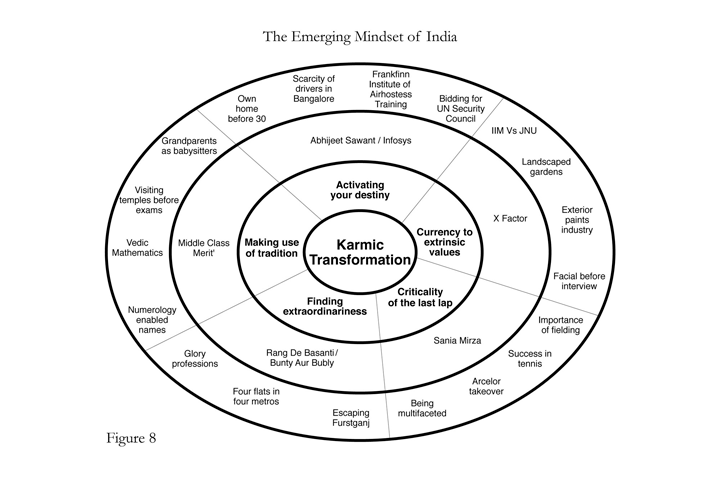
Understanding this larger shift in mindset is critical for established Indian businesses preparing to push themselves to the next level of growth and multinational businesses attempting to establish a deeper connect. A case in point is Marico Industries Limited (an Indian FMCG company), which has recently undertaken an exercise to get itself future ready by creating a more active, ‘Kshatriya’ culture for itself.
Creating A Kshatriya Culture At Marico
Marico as an organization has come a long way from being a subsidiary of Bombay Oil Industries. It has increased its turnover 10 times in last 15 years from a billion to 10 billion Rupees. Marico is set to enter its next phase of growth and wants to double its turnover by 2010. This requires Marico to be able to attract and retain the best talent available and create an organizational environment that can create a growth case study.
The problem however is that Marico is an unsung hero. Contrary to the reality on the ground, the organization is perceived as a small 4 billion-type company, which is entrepreneurial driven and thrives on traditionally strong Parachute and Saffola brands with little innovation to its credit. As a result its ability to be counted amongst the best and attract cutting edge talent gets confined.
As an organization, though Marico is a very progressive company. Three key ingredients of its company culture, which are ‘openness’, ‘empowerment’ and ‘meritocracy’, make it a very fertile organization. The company has no muster system, employees record their own leave and self authorize their expenses.
Interviewing throughout the company and contrasting that with outsiders’ views led us to a major and slightly scary discovery: not only had Marico outgrown its brand image, it had outgrown its own culture.
The key problem holding back Marico was identified as a ‘Brahminical Self Satisfaction’. In many ways, the organization placed over emphasis on correctness Vs play, on processes Vs end-values, on ability Vs flair. Marico carried the ‘burden of wisdom’. The ‘Brahminical’ values of correctness, process and ability that had fuelled early success had now created a glass ceiling of sorts. Mapping the company’s culture against the context of changing India, it appeared that Marico could shatter this ceiling by adding a strong dose of ‘Kshatriya’ values. That is, to achieve the image change it sought, Marico needed a culture change, just as India itself is experiencing.
The shift in the corporate culture of Marico was proposed from ‘Brahminical Self Satisfaction’ to ‘Kshatriya Flair’. It was proposed that Marico needed to infuse some Kshatriya values of celebration, glory, heroism and risk taking to its current value system of being hardworking, stable middle class organization. Marico needed to celebrate its buoyancy. In line with the larger mindset shift that India at large is going through.
The proposed brand Idea of Marico as an ‘Unboxed Organization’ found its voice in the creative articulation ‘Marico – Uncommon Sense’. Uncommon Sense as a creative thought captured Marico’s ability to play with the given boundaries in any context; whether in finding solutions to problems, in creating a fully democratic work place, in setting up business ambitions or in cross fertilizing learning and skills across categories and functions. Uncommon Sense said that there were synergies in unapparent things only if one tried to look beyond the obvious. More often than not newer ideas, and solutions happen by looking at the world through the eyes of Uncommon Sense.
A mass media campaign around the creative idea ‘Marico – Uncommon Sense’ was released in business newspapers and magazines and business channels. The internal campaign also focused on celebrating the ‘Uncommon Sense’ culture through various posters and internal event ideas. The website was suitably adapted to incorporate the new brand identity. Soon after the adoption of the new brand idea, Marico met in a larger group to re-craft its values for the next phase. And ‘opportunity seeking’, ‘boundarilessness’, ‘bias for action’ were included as some of the key values that the organization will live by.
The sound of shattering glass has awakened Marico, inside and out. In Marico’s own metrics, percentage of lateral recruitments of people with premier institute background went up from 22% in Jan-Dec’05 to 50% in Jan-July’06. Percentage of recruitment from companies, which are ranked equal to or better than Marico at premier business school campuses went up from 33% in Jan-Dec’05 to 64% in Jan-July’06.
The advertising campaign specifically received an immense feedback. A qualitative research that was conducted by an independent research agency Mode reported the impact of the mass media campaign as highly positive. In fact even competitors now talk about Marico as a place of fertility and empowerment. Much more than a brand campaign, Uncommon Sense has given Marico the confidence (and better, the talent) to create the business future its ‘un-commonsense thinking’ demands.
Conclusion
It’s imperative for brands and businesses seeking success with Indians to understand this larger cultural discourse. If this is the picture of how Indians are today thinking and behaving, the challenge for marketers is to find out how their brands can play a meaningful role in the lives of the people by leveraging these new codes. The impact of the new way of thinking is not only on the marketing of brands and services but also on things like attracting and recruiting cutting edge talent. The younger India today is clearly seeking a much more fertile work environment with a non-linear growth path and a job that brings them not just money but fame and fun as well. Similarly narratives of cinema, television serials and even advertising need to build themselves around this new sense of ambition and a confidence to achieve the desired goals backed by an ability of today’s Indians to push their gut till the last lap. Stories of destiny transformation have the potential to be the blockbusters at the box office.
These new cultural codes are already powering several existing and new categories and helping marketers tap mindsets. For instance, the grooming industry in India is on an unprecedented boom. To the extent that beauty parlours are mushrooming in every nook and corner. Even products for hair streaking have taken off in their own right. Similarly, markets for institutes providing training to become airhostesses, newsreaders and radio jockeys are taking off in a big way. In terms of brand promise, brands like Fair & Lovely (a Unilever brand of fairness cream), which promise a life transformation to the young women of India are being a big success and finding extensions into other categories. Alcohol and fashion brands alike are celebrating the newfound success of the young Indian. Talent shows are doing well on television. And traditional Indian organizations such as Tatas, Bajaj & Marico that embodied the middle class success are attempting a makeover to add some gloss variables, embracing the newer Kshatriya values.
India is today a part of almost every global company’s forward plan. The economy itself is booming with a projected GDP growth rate of 8 per cent and is expected to drive the world GDP upwards, together with its Asian counterpart China (UN, 2006). It’s only comforting to know that the hardware of Indian economics is finding a support in the software of this new culture. It’s the power of this larger socio-cultural movement that we can bank upon to sustain the surge and drive this economic renaissance, letting India overtake the per capita GDP of USA by 2030 (Wilson and Purushothaman, 2003).
Footnotes:
[1] Kshatriya:
One of the four main castes in the Indian social order, Kshatriya is the warrior class. They represent action, valour and competitive spirit. Kshatriya values have not been the dominant value system in the Indian society, shadowed by the high-grounded Brahminical value system.
[1] Brahminical:
Derived from ‘Brahmin’. Of the four main castes in the Indian society, Brahmins are at the top of the social order. Custodian of the religious sacrament, they are deemed to be the ‘learned’ of the society who has the knowledge of the religious text. They are the epitome of simple living and are looked upon for having renounced the craving for material pleasures of life
References:
Geertz, C. (1973), The Interpretation of Cultures, Basic Books, New York
Hofstede, G. (1991), Cultures and Organisations: Software of the Mind, McGraw-Hill, London
Sinha, D., Kamath, S. and Gupa, S. (2006), Creating a Kshatriya Culture at Marico, Management Communication Trends & Strategies, Tata McGraw-Hill, pp 345 – 353
United Nations (2006), World Economic Situation and Prospects 2006, United Nations Publication, New York
Wilson, D. and Purushothaman, R. (2003), Dreaming With BRICs: The Path to 2050, Global Economics Paper No: 99, pp 1-5
(This paper was first presented at Esomar Asia Pacific Conference)


No Comments